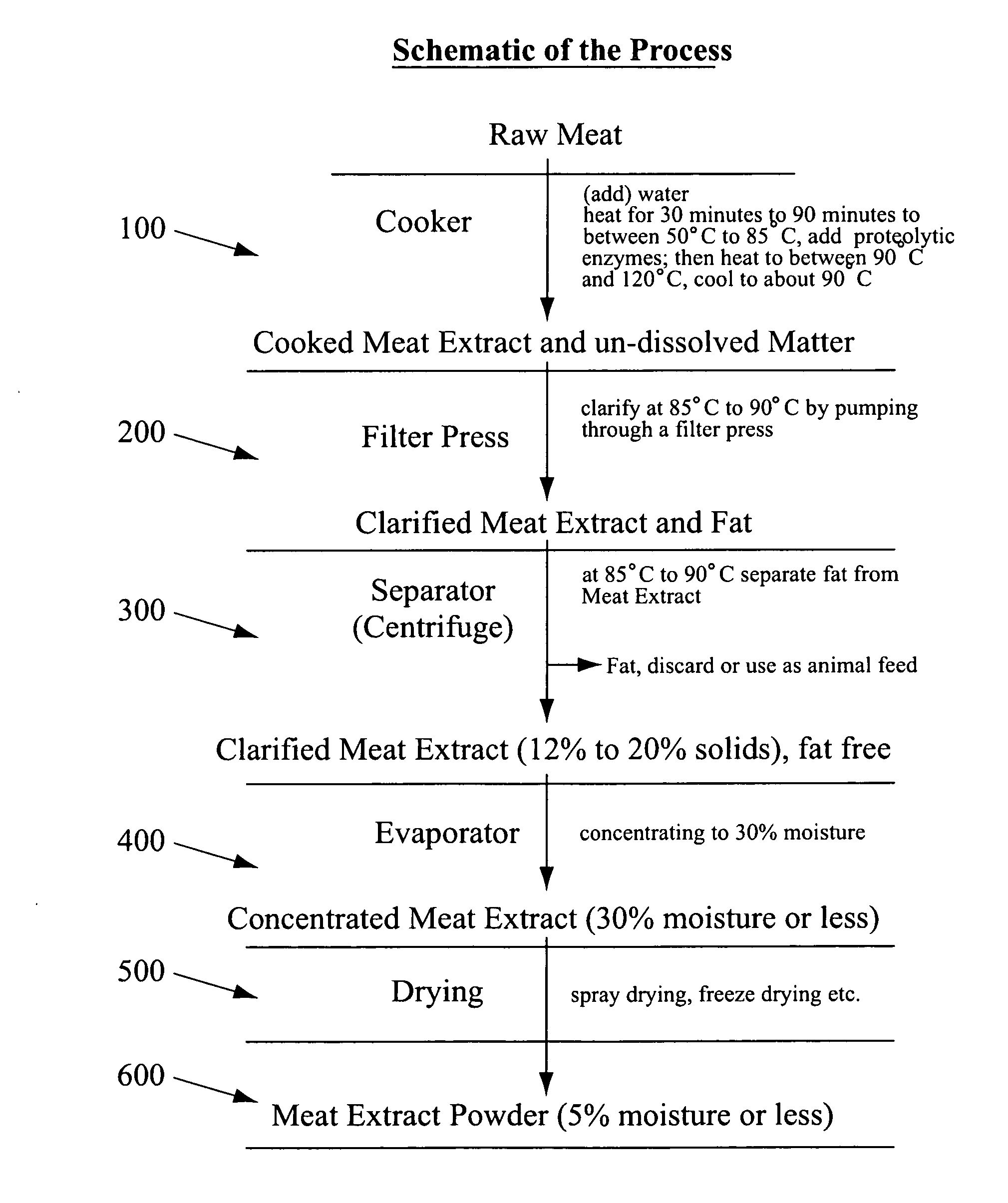Method of manufacturing meat extract, and meat extract
a technology of meat extract and meat, applied in the field of meat extract manufacturing, can solve the problems of substantial disadvantages of the product, both technologically and nutritionally, and is still a sticky material, and is difficult to handl
- Summary
- Abstract
- Description
- Claims
- Application Information
AI Technical Summary
Benefits of technology
Problems solved by technology
Method used
Image
Examples
example 1
[0062]
360.0 kg of Ground beef (32% fat) are placed into ajacketed blender with40.0 kg of Water and1.0 kg of Papain enzyme [an endopeptidase], e.g.,Purified Papain RS 600 (Activity: 600 TU / mg); EnzymeDevelopment Corporation, 21 Penn Plaza, New York, NY 10001.
[0063]Under agitation the mixture is heated to about 65° C. and held for about 45 minutes. The mixture then is heated to about 95° C., held for about 10 minutes and pumped through a filter press. The clarified extract is separated from its fat in a centrifuge. The final process step involved concentration by water evaporation in a falling film evaporator. About 41.3 kg of concentrated beef extract were recovered (about 11.5% of starting material).
[0064]The resulting beef extract concentrate has a typical analysis as follows:
Moistureabout 34.5%Proteinabout 57.4%Salt
[0065]The protein content of the starting beef meat was analyzed as about 14.9%. Thus the starting material contained about 53.6 kg of valuable beef protein. The recove...
example 2
[0066]
360.0 kg of Ground beef (32% fat) are placed into ajacketed blender with22.0 kg of Water and cooked under agitation at 80° C.for 30 minutes. The mixture is cooled with47.0 kg of ice-cold Water to 50° C. and then0.6 kg Papain enzyme and1.0 kg of Protease M [an exopeptidase mixture] areadded, e.g., Protease M (Activity: 5,500 u / g); Amano EnzymeUSA Co., 2150 Point Blvd., Elgin, IL 60123.
[0067]The extraction takes place at about 50° C. to 52° C. for about 50 minutes, and then is continued at about 120° C. for about another 15 minutes. After cooling to about 90° C. the extract is pumped through a filter press. The clarified extract is separated from its fat in a centrifuge. About 220.0 kg of clarified and fat-free beef extract were received. It had a moisture content of approximately 83%.
[0068]The final process step involved concentration by water evaporation in a falling film evaporator. 45.3 kg of concentrated beef extract were recovered (12.6% of starting material).
[0069]The res...
example 3
[0071]
300.0 kg of Mechanically Separated Chicken Meat (23.4% fat) and20.0 kg Water are cooked under agitation in a jacketed blender at 80° C.for 30 minutes. The mixture is cooled with40.0 kg of ice-cold Water to 50° C. and then0.5 kg Papain enzyme and0.8 kg of Protease M are added, e.g., Protease M (Activity: 5,500 u / g);Amano Enzyme USA Co., 2150 Point Blvd., Elgin, IL 60123.
[0072]The extraction takes place at about 50° C. to 52° C. for about 50 minutes, and then is continued at about 120° C. for about another 30 minutes. After cooling to about 90° C. the extract is pumped through a filter press. The clarified extract is separated from its fat in a centrifuge. About 200.0 kg of clarified and fat-free chicken extract were received. It had a moisture content of approximately 87%.
[0073]The final process step involved concentration by water evaporation in a falling film evaporator. About 41.5 kg of concentrated chicken extract were recovered (about 13.8% of starting material).
[0074]The ...
PUM
 Login to View More
Login to View More Abstract
Description
Claims
Application Information
 Login to View More
Login to View More - R&D
- Intellectual Property
- Life Sciences
- Materials
- Tech Scout
- Unparalleled Data Quality
- Higher Quality Content
- 60% Fewer Hallucinations
Browse by: Latest US Patents, China's latest patents, Technical Efficacy Thesaurus, Application Domain, Technology Topic, Popular Technical Reports.
© 2025 PatSnap. All rights reserved.Legal|Privacy policy|Modern Slavery Act Transparency Statement|Sitemap|About US| Contact US: help@patsnap.com

